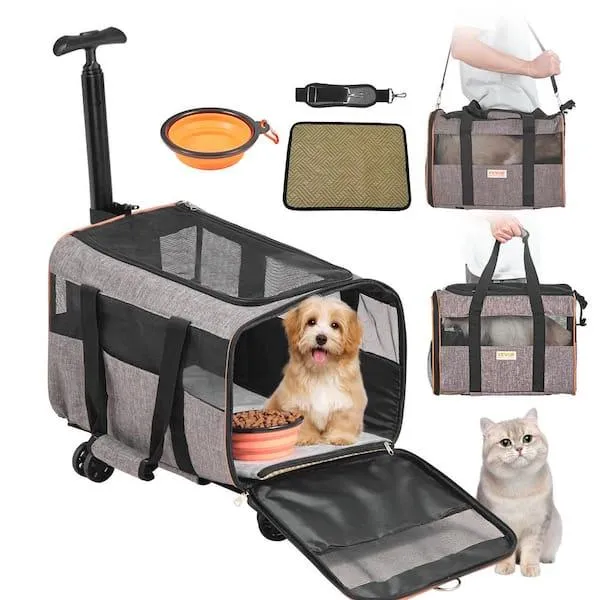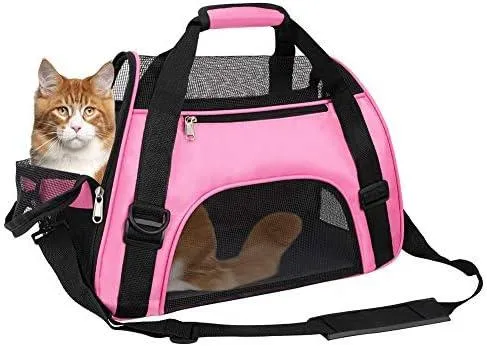Choosing the Right Pet Carrier for Air Travel:
Whether you’re taking a family vacation or relocating to a new home, traveling with your furry friend by air can be a stressful experience for both you and your pet. With so many carrier options on the market, it’s easy to feel overwhelmed when trying to select the best one for your pet’s needs and airline requirements. In this article, I’ll break down the most important factors to consider and provide recommendations for different pet types to help ensure a smooth flying experience.
Airline Regulations
The first step is checking your airline’s policies regarding pet carriers. Most carriers have strict size and security requirements that the container must meet in order to be considered an “in-cabin pet carrier.” For example, many airlines only allow soft-sided carriers that are no larger than 18x14x8 inches to fit safely under the seat. It’s crucial to verify allowable dimensions before making your purchase to avoid any issues at the airport.
Pet Type and Size
Naturally, the size and needs of your pet will be a major determining factor. For cats and small dogs under 20 lbs, a soft-sided carrier is generally most suitable. Larger dogs may require a more heavy-duty plastic or metal carrier that provides adequate ventilation. Consider these key points based on your pet:
- Dogs: Look for an escape-proof carrier at least 6 inches taller than your dog when standing. Avoid mesh doors if anxious.
- Cats: Opt for a carrier with multiple entry points and soft walls vs bars for comfort. Secure zippers to prevent escapes!
- Small Animals: A ventilated hard plastic case works well for hamsters, birds, etc. Ensure adequate space for food, water.
Comfort and Ventilation
No pet wants to be cooped up for hours in a hot, stuffy carrier. Look for bags with mesh panels, zippered windows, or accordion-style sides for optimal airflow. Padded, plush interiors provide cushioning on long flights. And don’t forget essentials like a cozy blanket, toys or treats to make the experience more pleasant!
Durability
Pet carriers see a lot of use over the years, from hauling to and from vet visits to trips with friends. Opt for a sturdy, crash-test design capable of withstanding bumps during travel without compromising escape-proof security. Reinforced seams and zippers stand up best to wear and tear in my experience. Avoid flimsy or cheaply made bags.

Ease of Carry
A good carrier folds up small when not in use yet has comfortable handles or shoulder straps for luggage-loads through the airport. Look for models with trolley sleeves or skid plates if trekking long distances too. Having both front and top opening access lets you easily comfort pets inside. Some even convert to backpacks which is kind of awesome!
Cost
Budget can range greatly depending on materials, but expect to pay $30-$150 usually. Cheaper mesh-only carriers lack durability while high-end specialty bags offer worthwhile perks. I’ve found the $50-80 mid-range to strike the best balance of quality, features and value in most cases. It’s definitely worth investing in reliable transportation if traveling frequently.
Real-Life Examples:
Here are some carrier recommendations I’ve used successfully with my own pets:
For Cats:
The Abecor Soft-Sided Pet Carrier is amazingly nice for cats. The plush interior, multiple zippered access points and lightweight yet durable material made Mimi feel totally at ease during our move across states. She even napped the whole way!
For Small Dogs:
My toy poodle Oscar adored travelling in the Petmate Vari-Kennel thanks to the reinforced mesh construction keeping him cool on flights while still feeling secure. The dual doors and extendable handle made it so easy to schlep through airports too.

For Large Dogs:
As an 80lb golden retriever, Bruno strongly preferred the Sleepy Pod Air for its expansive interior, impact-resistant aviation plastic, and comfy orthopedic foam bed perfect for longer journeys. The tubular aluminum frame proved very durable over many trips as well.
Final Thoughts
With so many quality options on the market today, finding the perfect travel carrier has basically gotten easier than ever before. But don’t forget to consider your own lifestyle needs too – like luggage compatibility, budget and duration of trips. Generally speaking, focusing on comfort, safety and airline requirements will lead you to a product your furry friend approves of too. Happy travels!
I hope reviewing the key factors and real-life examples has helped give you more confidence in selecting the best carrier match for your pet. Please feel free to leave any other questions in the comments. Wishing you both safe and stress-free flying experiences from now on. Bon voyage!
Top Pet Carriers for Airplane Travel
| Carrier | Size | Weight Limit | Airline Approval | Features |
|---|---|---|---|---|
| Sherpa Original Deluxe Carrier | Medium | 15 lbs | Most Major Airlines | Padded, ventilated, collapsible |
| Pet Gear IGO2-Stage Airline Approved | Large | 22 lbs | All Airlines | Expandable, handles, water bowl |
| Kennel Ventilation Travel Crate | X-Large | 25 lbs | Most Airlines | Ventilated sides, handles, divider panel |
| Snoozer Lookout Pet Carrier | Medium | 16 lbs | Most Major Airlines | Padded, ventilated, collapsible |
FAQ
-
What size pet carrier is best for an airplane?
Most airlines allow pet carriers that are up to about 18 inches long by 14 inches wide by 8 inches tall. However, you may want to double check with the specific airline you’re flying. Basically, go with a carrier size that’s kind of on the smaller side so it meets requirements and your pet feels cozy but not crammed.
-
Can I bring a soft-sided carrier on a plane?
While some airlines let you bring soft carriers, others require a hard-sided carrier. It depends on the rules for the airline. At the same time, soft carriers may not protect your pet as well if there’s turbulence or a bumpy landing. So if possible, I’d go with a sturdy hard-sided carrier despite being a little heavier. Hey, what’s more important – your arms getting tired or your pet’s safety?

-
Is it better to sedate my pet for the flight?
This depends on your pet. Some animals really don’t like it and sedation can possibly cause other issues. Perhaps talk to your vet about the risks and benefits based on your pet. If they’re usually very anxious, a mild sedative may help. But if they’re normally fine in the carrier, sedation may do more harm than good. I’d say listen to what your vet recommends for your pet’s personality.
-
What else do I need to bring for my pet?
In addition to the carrier, bring water for your pet, a leash, a pee pad or two, a favorite toy or treat for comfort, and ID tags with your contact info in case they get lost. You might also pack some plastic bags for cleaning up accidents. Oh, and don’t forget documents like medical records in case they’re requested by the airline. I’d also advise having your pet microchipped in case of chaos at the airport.
-
Can I use an airline-approved carrier as my carry-on bag?
Good question! Most airlines allow you to use a pet carrier that fits under the seat as your one personal item allowed in the cabin. Nevertheless, you still have to purchase a plane ticket for your furry friend too. So basically, yes you can treat it as your carry-on but your pet counts as cargo. Check the airline policies for any size or weight restrictions. Overall it’s likely the most convenient option if their rules permit it.
-
What is the safest way to store the carrier under my seat?
Many experts agree that centering the carrier on the floor between your feet is optimal. This placement helps prevent it from shifting during taxi, takeoff, and landing. You may want to use ropes or straps to secure it tightly to the seat legs too. I’d avoid putting it in the overhead bin since it could fall out. Don’t leave your pet alone, bring them in the cabin with you if you can. Who wants to be stuck in a dark, cramped space for hours, right? Stay near for comforting and check on air vents.
-
Anything else I should know?
It’s always good to do test runs with your pet in the carrier before flying to get them used to it. Make it a positive space through training so they associate it with treats, not stress. Also, check on your pet frequently during the flight for signs of overheating, stress, etc. Is your pet crate-trained? If so, it can be very helpful for plane travel too. Lastly, bring plenty of patience – flying isn’t exactly ideal for anyone, as the saying goes!

